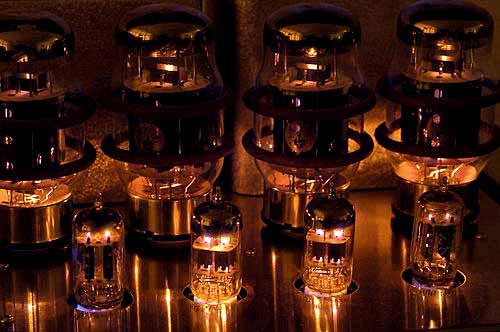In a tube amplifier, the signal is amplified using vacuum tubes, physical components that invariably have small variations and flaws. These imperfections are what give tube amp tones their distinctive color. In a solid-state amp, electronics like diodes and transistors do the signal amplification. Solid state amplifiers are capable of getting a much cleaner signal, but ultimately do their jobs too well; they can’t give the tone the same shimmer it gets from a tube-driven system.
The main disadvantage of tube amplifiers is the cost, both the initial investment and the ongoing replacement of the tubes as they burn out. Guitar enthusiasts will tell you a good tube amp is worth the money, but since they are more of an investment, you should be sure of what sound you’re going for before you take the leap (and we go into more detail into what to look for in clean tube amps after the our products below).
But first, without much ado, here are our recommendations for the 4 best clean tube amps on the market:
Fender Super Reverb
A re-issue of the ground breaking amp from 1965, the Fender Super Reverb is a faithful reproduction of the much-loved vintage model. It has a distinctive bright tone with a scooped mid-range. It’s exceptionally transparent when it’s running clean but can also be cranked for great overdrive. The sound lends itself best to rock, blues, and country, styles that suit the classic American tone this amplifier does so well. It comes equipped with four 10” Jensen P-10R speakers, which brings sparkling detail to the higher tones and adds a warmth that compliments the Super Reverb’s sound.
Orange Rocker 15 Tube Combo Amp
Here’s a great little all-tube amp that gives you a surprising amount of power for its size. The Orange Rocker 15 is a 1X10” combo amp with an on-board effects loop. It’s the perfect size for home play and small clubs, and is a great portable option for gigging musicians. The clean tone out of the Orange Rocker is sparkling and transparent, letting your guitar’s natural beauty sing.
The Voice of the World speaker that comes installed in this amp has a fantastic sound with a rich midrange. If you do want distortion, you’ll get a classic British fuzz out of the Rocker when you push the gain. It’s a versatile and high-quality amp for any level of player.
Peavey Classic 50/212 Tweed
The Peavey Classic is an old-school amp for the modern world with a basic and intuitive design that’s built for life on the road. The control panel is chrome and the switches all-steel for ultimate durability. The clean tone stays pure at even high dynamic levels and the combination of 12AX7 and EL84 tubes strike a nice balance between warmth and articulation and the Blue Marvel speakers are a perfect match for the tone. The tweed exterior gives it a clean, sophisticate look that’s a perfect match for the sound. The modern comes from features like the footswitch channel switching and the variety of tone controls, including reverb level and pre- and post-gain tone tweaking options. If you like portability, this just might be the best clean tube amp on the market.
Marshall DSL5C
Tube amps don’t come cheap, but you can find fantastic and authentic tube sound in a reasonable price with the Marshall DSL5C. Powered by a combination of ECC83 and ECC99 tubes, it combines the best aspects of vintage and modern Marshall styles. Clean tones are glassy in their clarity, aided by the included Celestion Ten-30 10” custom-voiced speaker. The ruggedly constructed cabinet has a classic Marshall look and control lay-out, and gives you lots of control over your sound, with two foot switchable channels, a deep switch to give your low end more definition, and rear-panel by-passable effects loop. If you’re on a budget, this just might be the best clean tube amp for the money.
Getting the Best Clean Tone
Adjusting the settings on your amp to get a good clean tone (i.e., without distortion) can be tedious and potentially intimidating if you’re newer to the world of guitar amplification. Amps that have a gain adjustment will give you the most control, but even if you only have volume and EQ knobs there are some things you can do to get your optimal clean tone.
First of all, set the guitar’s volume (the knob that’s on your actual instrument) all the way to the top at 10 and leave it there. Most guitars are designed to sound their best at maximum volume, and if the signal coming out of your guitar is constant you’ll have an easier time fine-tuning it at the amp level.
Use the master volume on your amp to control its overall output. If your amp has a volume control at the channel level, set it somewhere towards the middle (around 5 to 7). Altering this won’t affect your tone as much as the guitar volume, but your sound will stay the most consistent if you only use the master volume for dynamic control.
To get your baseline clean tone, start with all the frequency knobs on your amp set to 5. The mids have the most impact on your sound characteristics, while the treble tends to be the most delicate and should be adjusted carefully. If your sound feels hollow, try turning the mids down a notch and putting the bass up to 7 or 8. If the sound feels too heavy, cut the bass down to 2 or 3. You can cut the treble down to 4 if the sound is too piercing or bright, but don’t reduce the treble too much or you may find your sound getting lost in the mix once you’re playing with your bandmates.
There is no such thing as a perfect amp EQ. Even the same guitarist on the same instrument will need to make minor tweaks depending on the other musicians and the acoustics of the venue. Finding your personal ideal settings in the practice room, though, will make for more subtle adjustments when you’re at rehearsals and gigs, letting you find your ideal clean tone more quickly on the fly.
Replacing Tubes
Even in the best clean tube amps, most tubes will last several years before failing, but if you have a used amp or play a lot, you might find yourself needing to replace the tubes. There are differing opinions on when to replace tubes, but if your amp isn’t giving you the clean tone you expect, changing them could improve the sound production.
Check inside your amp and see if the vacuum in any of your tubes has been compromised. Sometimes this will be easy to tell because the entire tube will have burst, but small cracks can also form, leaving the tube apparently intact. You’ll know the vacuum’s been compromised if the metallic layer at the top of the tube is white or stained with milky discolorations. Tube failures like this tend to happen most often when the amp gets dropped or jostled, so be sure to check your tubes if your amp takes a spill.







